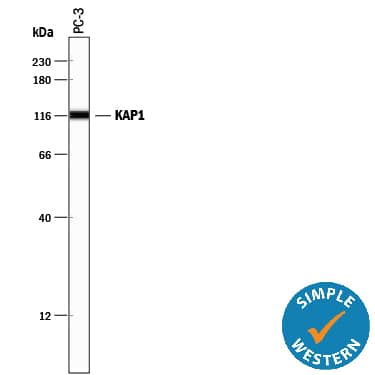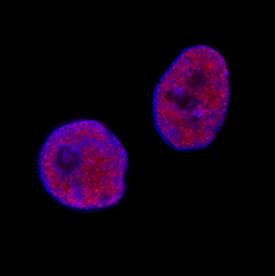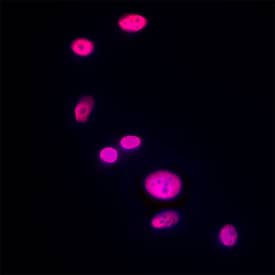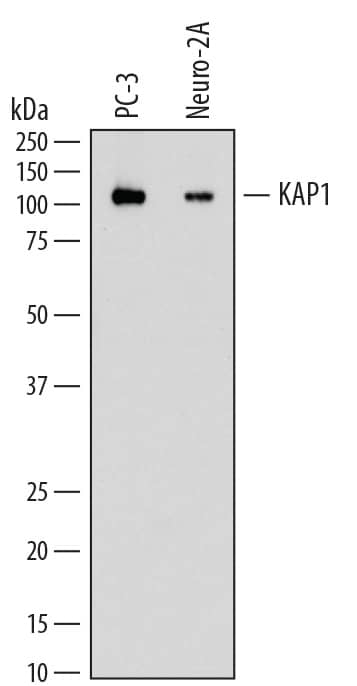Human KAP1 Antibody
R&D Systems, part of Bio-Techne | Catalog # MAB7785

Key Product Details
Species Reactivity
Human
Applications
Immunocytochemistry, Immunohistochemistry, Simple Western, Western Blot
Label
Unconjugated
Antibody Source
Monoclonal Mouse IgG2B Clone # 821912
Product Specifications
Immunogen
E. coli-derived recombinant human KAP1
Lys266-Ser624
Accession # Q13263
Lys266-Ser624
Accession # Q13263
Specificity
Detects human KAP1 in direct ELISAs and Western blots.
Clonality
Monoclonal
Host
Mouse
Isotype
IgG2B
Scientific Data Images for Human KAP1 Antibody
Detection of Human and Mouse KAP1 by Western Blot.
Western blot shows lysates of PC-3 human prostate cancer cell line and Neuro-2A mouse neuroblastoma cell line. PVDF membrane was probed with 0.2 µg/mL of Mouse Anti-Human KAP1 Monoclonal Antibody (Catalog # MAB7785) followed by HRP-conjugated Anti-Mouse IgG Secondary Antibody (HAF018). A specific band was detected for KAP1 at approximately 105 kDa (as indicated). This experiment was conducted under reducing conditions and using Immunoblot Buffer Group 1.Detection of Human KAP1 by Simple WesternTM.
Simple Western lane view shows lysates of PC‑3 human prostate cancer cell line, loaded at 0.5 mg/mL. A specific band was detected for KAP1 at approximately 117 kDa (as indicated) using 2 µg/mL of Mouse Anti-Human KAP1 Monoclonal Antibody (Catalog # MAB7785). This experiment was conducted under reducing conditions and using the 12-230 kDa separation system.KAP1 in Neuro‑2A Mouse Cell Line.
KAP1 was detected in immersion fixed Neuro-2A mouse neuroblastoma cell line using Mouse Anti-Human KAP1 Monoclonal Antibody (Catalog # MAB7785) at 8 µg/mL for 3 hours at room temperature. Cells were stained using the NorthernLights™ 557-conjugated Anti-Mouse IgG Secondary Antibody (red; NL007) and counterstained with DAPI (blue). Specific staining was localized to nuclei. View our protocol for Fluorescent ICC Staining of Cells on Coverslips.Applications for Human KAP1 Antibody
Application
Recommended Usage
Immunocytochemistry
8-25 µg/mL
Sample: Immersion fixed Neuro-2A mouse neuroblastoma cell line and PC-3 human prostate cancer cells
Sample: Immersion fixed Neuro-2A mouse neuroblastoma cell line and PC-3 human prostate cancer cells
Immunohistochemistry
0.5-25 µg/mL
Sample: Immersion fixed paraffin-embedded sections of human liver cancer tissue
Sample: Immersion fixed paraffin-embedded sections of human liver cancer tissue
Simple Western
2 µg/mL
Sample: PC‑3 human prostate cancer cell line
Sample: PC‑3 human prostate cancer cell line
Western Blot
0.2 µg/mL
Sample: PC‑3 human prostate cancer cell line and Neuro‑2A mouse neuroblastoma cell line
Sample: PC‑3 human prostate cancer cell line and Neuro‑2A mouse neuroblastoma cell line
Reviewed Applications
Read 1 review rated 5 using MAB7785 in the following applications:
Formulation, Preparation, and Storage
Purification
Protein A or G purified from hybridoma culture supernatant
Reconstitution
Sterile PBS to a final concentration of 0.5 mg/mL. For liquid material, refer to CoA for concentration.
Formulation
Lyophilized from a 0.2 μm filtered solution in PBS with Trehalose. *Small pack size (SP) is supplied either lyophilized or as a 0.2 µm filtered solution in PBS.
Shipping
Lyophilized product is shipped at ambient temperature. Liquid small pack size (-SP) is shipped with polar packs. Upon receipt, store immediately at the temperature recommended below.
Stability & Storage
Use a manual defrost freezer and avoid repeated freeze-thaw cycles.
- 12 months from date of receipt, -20 to -70 °C as supplied.
- 1 month, 2 to 8 °C under sterile conditions after reconstitution.
- 6 months, -20 to -70 °C under sterile conditions after reconstitution.
Background: KAP1
Long Name
KRAB-associated Protein 1
Alternate Names
KRIP-1, RNF96, TF1B, TIF1B, TRIM28
Gene Symbol
TRIM28
UniProt
Additional KAP1 Products
Product Documents for Human KAP1 Antibody
Product Specific Notices for Human KAP1 Antibody
For research use only
